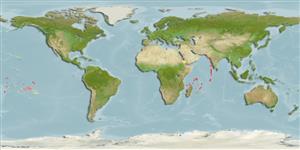>
Holocentriformes (Squirrelfishes, soldierfishes) >
Holocentridae (Squirrelfishes, soldierfishes) > Holocentrinae
Etymology: Sargocentron: Greek, sargos = sargus + Greek, kentron = sting (Ref. 45335); inaequalis: From the unequal length of the serrae in the series along the posterior edge of the preopercle..
More on authors: Randall & Heemstra.
Environment: milieu / climate zone / depth range / distribution range
Ökologie
seewasser riff-verbunden; tiefenbereich 6 - 10 m (Ref. 7459). Tropical
Western Indian Ocean: Chagos Archipelago, Comoro Islands, Seychelles, Reunion. Central Pacific: Line Islands (Kiribati).
Size / Gewicht / Alter
Maturity: Lm ? range ? - ? cm
Max length : 11.3 cm SL Männchen/unbestimmt; (Ref. 27370)
Rückenflossenstacheln (insgesamt): 11; Rückenflossenweichstrahlen (insgesamt): 13; Afterflossenstacheln 4; Afterflossenweichstrahlen: 9. Pale red in color with edges of the scales darker red; a narrow darker red stripe between scale rows of the body; pelvis and spinous dorsal fines red. 4-5 oblique rows of scales on cheek. Body depth 2.5-2.8 in SL; head length 2.5-2.7 in SL; short snout, 4.25-4.85 in head length; interorbital width 4.75-5.0 in head length; lower jaw slightly inferior. Maxilla extending to between verticals at anterior edge of the iris and slightly posterior to center of the eye, upper jaw length 2.5-2.8 in head length; rounded anterior end of nasal bone; moderately large nasal fossa spineless; retrorse spine on nasal bone between the nasal fossa and edge of premaxillary groove; median edge of nasal bone (premaxillary groove margin) with a small recumbent retrorse spine; preopercular spine, 1.5-1.9 in orbit diameter; posterior edge of preopercle with unequal spinules, some 3-4 times longer than adjacent spines, and few in number (21-23, 6.75-7.2 cm SL); longest dorsal spines, 1.85-2.25 in head length; third anal spine 1.6-1.9 in head length. Rounded caudal fin lobes (Ref. 27370).
An uncommon inhabitant of lagoon reefs (Ref. 9710). Seen only from poison stations (Ref. 9710).
Life cycle and mating behavior
Geschlechtsreife | Fortpflanzung | Ablaichen | Eier | Fecundity | Larven
Randall, J.E., 1998. Revision of the Indo-Pacific squirrelfishes (Beryciformes: Holocentridae: Holocentrinae) of the genus Sargocentron, with descriptions of four new species. Indo-Pac. Fish. (27):105 p. (Ref. 27370)
IUCN Rote Liste Status (Ref. 130435)
Bedrohung für Menschen
Harmless
Nutzung durch Menschen
Mehr Information
NamenSynonymeMetabolismusRäuberÖkotoxikologieFortpflanzungGeschlechtsreifeAblaichenSpawning aggregationFecundityEierEientwicklung
Alter/GrößeWachstumLänge-GewichtLänge-LängeLängenhäufigkeitenMorphometrieMorphologieLarvenLarven Pop.Dyn.RekrutierungDichteBRUVS
ReferenzenAquakulturAquakultur ProfilZuchtlinienGenetikElectrophoresesVererbbarkeitKrankheitenVerarbeitungNutrientsMass conversion
PartnerBilderStamps, Coins Misc.LauteCiguateraGeschwindigkeitSchwimmstilKiemenoberflächeOtolithsGehirngrößeSehfähigkeit
Tools
Zusatzinformationen
Download XML
Internet Quellen
Estimates based on models
Preferred temperature (Ref.
123201): 25.7 - 29, mean 27.7 °C (based on 339 cells).
Phylogenetic diversity index (Ref.
82804): PD
50 = 0.5000 [Uniqueness, from 0.5 = low to 2.0 = high].
Bayesian length-weight: a=0.01622 (0.00774 - 0.03400), b=2.97 (2.80 - 3.14), in cm total length, based on LWR estimates for this Genus-body shape (Ref.
93245).
Trophic level (Ref.
69278): 3.5 ±0.5 se; based on size and trophs of closest relatives
Widerstandsfähigkeit (Ref.
120179): hoch, Verdopplung der Population dauert weniger als 15 Monate. (Preliminary K or Fecundity.).
Fishing Vulnerability (Ref.
59153): Low vulnerability (10 of 100).
